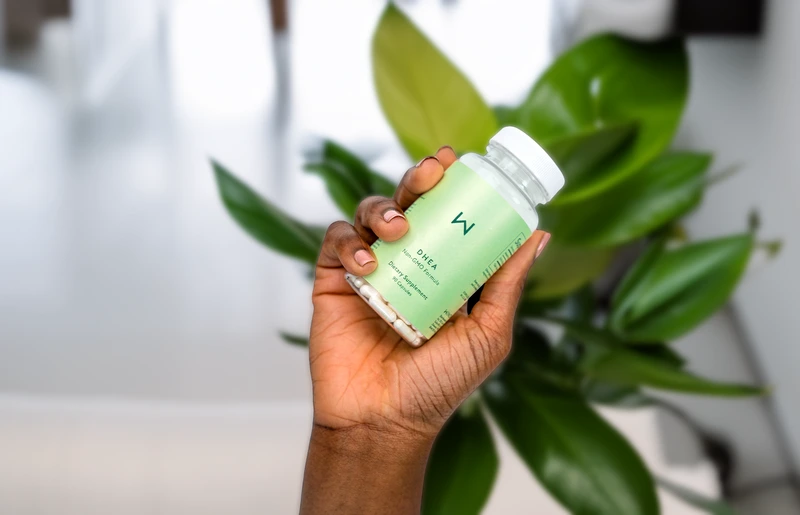Produced in both male and female bodies, dehydroepiandrosterone (DHEA) is a sex steroid precursor that gets converted into estrogens and androgens, such as testosterone. It’s responsible for the majority of androgen production in females. DHEA levels peak in a woman’s 20s but decline with age, dropping by 60% by the time a woman enters menopause.(1)
During this phase of life, DHEA may be used to increase the body’s testosterone levels to treat symptoms associated with the natural thinning of vaginal tissue. These symptoms may include pain during sex, vaginal dryness, and changes in sexual functioning. Supplementation may also improve skin and mood changes that commonly occur during menopause.(1)(2)The sulfated form of DHEA is dehydroepiandrosterone sulfate (DHEA-S), which is the most abundant adrenal androgen in the human body.(1) DHEA-S levels also decline as women age. This article will detail the similarities and differences between DHEA and DHEA-S and how DHEA supplements may help reduce common menopausal symptoms.
DHEA vs. DHEA-S
DHEA is an active metabolite, while DHEA-S can be thought of as the inactive form.(3)(4) Both DHEA and DHEA-S are produced in the brain, gonads, and adrenal glands. DHEA is primarily secreted by the adrenal cortex — the outer region of the adrenal glands — and is converted into DHEA-S.(5)(6) Acting as a storage reserve, DHEA-S can be converted back into DHEA as needed.(1)
Between the two, DHEA is used more often as a supplement than DHEA-S. Supplements use bioidentical DHEA, which more closely mimics the molecular structure of the body’s natural hormones.

Main Differences Between DHEA and DHEA-S
While DHEA and DHEA-S do share some similarities, the two differ in bioavailability, stability, usage, and more. The key differences between DHEA and DHEA-S are as follows.
Feature | DHEA | DHEA-S |
|---|---|---|
FORM | Bioidentical hormone supplement | Sulfated form of DHEA |
PRODUCTION | Mainly produced in the adrenal cortex | Naturally produced in the adrenal glands, gonads, and brain |
FUNCTION | Precursor to sex hormones like testosterone and estrogen | Storage form to be converted back to DHEA when needed |
STABILITY | Short half-life | Long half-life |
BIOAVAILABILITY | Can easily cross the blood-brain barrier | Cannot readily cross the blood-brain barrier |
USAGE | Taken orally once a day | Not typically used as a supplement |
BENEFITS | Increases testosterone levels to improve muscle mass, bone strength, and vaginal symptoms | Serves as a stable reservoir of DHEA for conversion to sex steroid hormones |
TESTING | Difficult to measure since the majority of DHEA gets converted to DHEA-S | Overall DHEA levels assessed by DHEA-S blood tests |
Although both are produced by the same organs, the key difference between DHEA and DHEA-S is that DHEA is a sex steroid precursor and the other is its sulfated form, which can be stored and converted back to DHEA. The two also have marked differences in half-life, ability to cross the blood-brain barrier, and means of testing. Here’s how DHEA and DHEA-S specifically differ in each of these categories:
Chemical Structure: As a chemical derivative of DHEA, DHEA-S contains a molecule group consisting of sulfate and oxygen atoms. Both DHEA and DHEA-S are considered weak androgens, with DHEA-S exhibiting only 5% of the androgenic activity of testosterone.(7)
Stability: DHEA-S is considered more stable than DHEA, giving it a longer half-life. Half-life refers to how long it takes for blood concentrations of a substance to decrease by half. Compared to DHEA-S, DHEA clears more quickly from the plasma and binds weakly to albumin in the blood, resulting in a shorter half-life.
Some research shows DHEA to have a maximum half-life of 30 minutes, while other studies indicate a half-life of 1 to 3 hours. In comparison, DHEA-S has been shown to have a half-life of approximately 7 to 10 hours, with some studies suggesting closer to 10 to 20 hours.(8)(9)
Bioavailability: The blood-brain barrier is a protective membrane that selectively allows certain molecules to pass through while blocking the entry of potentially harmful substances. DHEA can easily cross this barrier, whereas DHEA-S cannot, giving DHEA greater bioavailability.(5)(10)
Stress Response: Both DHEA and DHEA-S have been linked to psychological stress. While DHEA-S is more closely associated with chronic stress, DHEA plays a role in the body’s immediate response to short-term stress.
A study published in Biological Psychology found that while both DHEA and DHEA-S levels increased in adults experiencing acute stress, DHEA levels showed greater variation in response magnitude among participants.(11)
Testing Ability: DHEA is hard to measure because over 99% of it gets metabolized into DHEA-S before being released into the body.(12) Because DHEA-S is more abundant, it’s easier to monitor its levels through blood testing.
Why Choose DHEA over DHEA-S?
Although a healthcare provider may recommend DHEA-S in some cases, there are currently no clinical guidelines for its use in hormone therapy. Bioidentical DHEA supplements are available over-the-counter (OTC) or by prescription, and oral forms can be taken once a day.
Unlike its sulfated form, DHEA can easily pass through the blood-brain barrier and respond to acute stressors. While DHEA-S serves as a storage reserve for sex steroid conversion, it’s the active metabolite (DHEA) that can help raise testosterone levels, potentially improving muscle mass, bone mineral density, and vaginal symptoms related to declining hormone levels during menopause.
